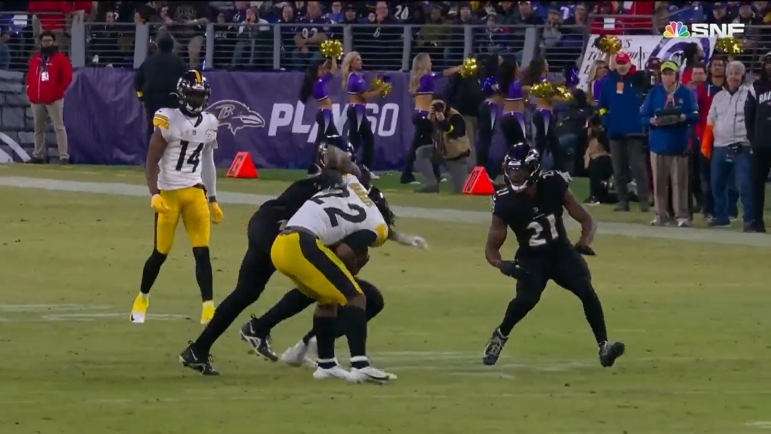If you’ve followed the site for awhile, you know we are all about two things. Tape and statistics. Being able to marry the two is the ultimate goal. Today’s post will focus on the latter and highlight four advanced metrics where the Pittsburgh Steelers struggled last year and need to improve if they want to get back into the playoffs in 2023.
1. Team YAC (4.0 Per Reception In 2022)
An obvious point we’ve made many times before. Not only did the Steelers’ offense finish last in YAC per reception a year ago, just 4.0, they were comfortably in the league’s basement. By comparison, the 31st-ranked team was the Buffalo Bills at 4.4, nearly a half-yard ahead of the Steelers.
Getting better here is multi-fold. Matt Canada must utilize his receivers’ route tree to allow for more YAC opportunities. Diontae Johnson didn’t get the ball on enough slants or crossing routes a year ago, a big drop compared to previous seasons. The receivers must improve, too, with Johnson going forward, not backwards, and George Pickens becoming a more refined and nuanced route runner to further expand his route tree. Quarterbacks play a role here too. Kenny Pickett needs to improve his accuracy and ball placement, especially on throws outside and to the flat/sideline. That impacts YAC.
2. Najee Harris Yards Before Contact (2.1 In 2022)
It’s been tough sledding for Najee Harris over his two years in the NFL, playing behind ever-changing Steelers’ offensive lines. His 2022 numbers did improve compared to 2021 but they still weren’t good enough. His average of 2.1 yards before contact ranked 35th out of 41 running back qualifiers, barely more than the likes of Kareem Hunt and Cam Akers.
Some of that falls on Harris. He didn’t always hit the hole hard enough, but this is more of an offensive line stat than it is falling at Harris’ feet. Pittsburgh improved its front five this offseason with Isaac Seumalo and Broderick Jones, though the latter isn’t assured to start, and Harris’ numbers should again improve this year. The target? Get over three yards and you’ll be creeping in on the top ten. It’s a big jump but for a run-heavy offense, that’s where Pittsburgh should want to be.
3. Kenny Pickett Adjusted Yards Per Passing Attempt (5.5)
No qualified quarterback in the NFL had as low of a figure here as Pickett’s 5.5, 33rd out of 33 players. The company right above him aren’t names you want in your corner either: Carson Wentz, Baker Mayfield, and Davis Mills.
Being able to push the ball downfield and create more explosive plays will help boost this figure. So will increasing YAC. And it’s not like you need to have a cannon for an arm to put up a respectable number. Jimmy Garoppolo, Jared Goff, and Andy Dalton all finished in the top ten in this stat a year ago.
The sliver of good news is that following the bye, Pickett’s figure improved from 3.89 to 6.7, the latter ranking 21st in football from Weeks 10-18. It’s still not where he wants to be, but it was real progress as he settled into the Steelers’ offense, even if they played things conservatively. I’d like to see this number for the entire season crack at least 7.0.
4. Steelers High Blitz Rate + Low Pressure/Hurry Rate
I couldn’t make this post all about the Steelers’ offense. Of course, this stat was largely impacted by the loss of T.J. Watt in the season opener until after the bye week. Still, Pittsburgh had the sixth-highest blitz rate (31.5%) in football last season yet it had the third-lowest hurry rate (4.5%) and the third-lowest pressure rate (17.4%). High blitz rates combined with low pressure rates are the opposites of what you want as a defense. I understand why the numbers are what they are — the lack of front four pressure caused Pittsburgh to try and blitz more — but it was still ineffective.
Naturally, Pittsburgh’s pressure rate rose once Watt returned but still had dud performances later in the season, just 14.3% against Las Vegas in Week 16 and 8.0% the following week against Baltimore. Getting back to 2021 numbers where Pittsburgh had the 13th-highest blitz rate and the NFL’s 7th-best pressure rate is much closer to expectations.








